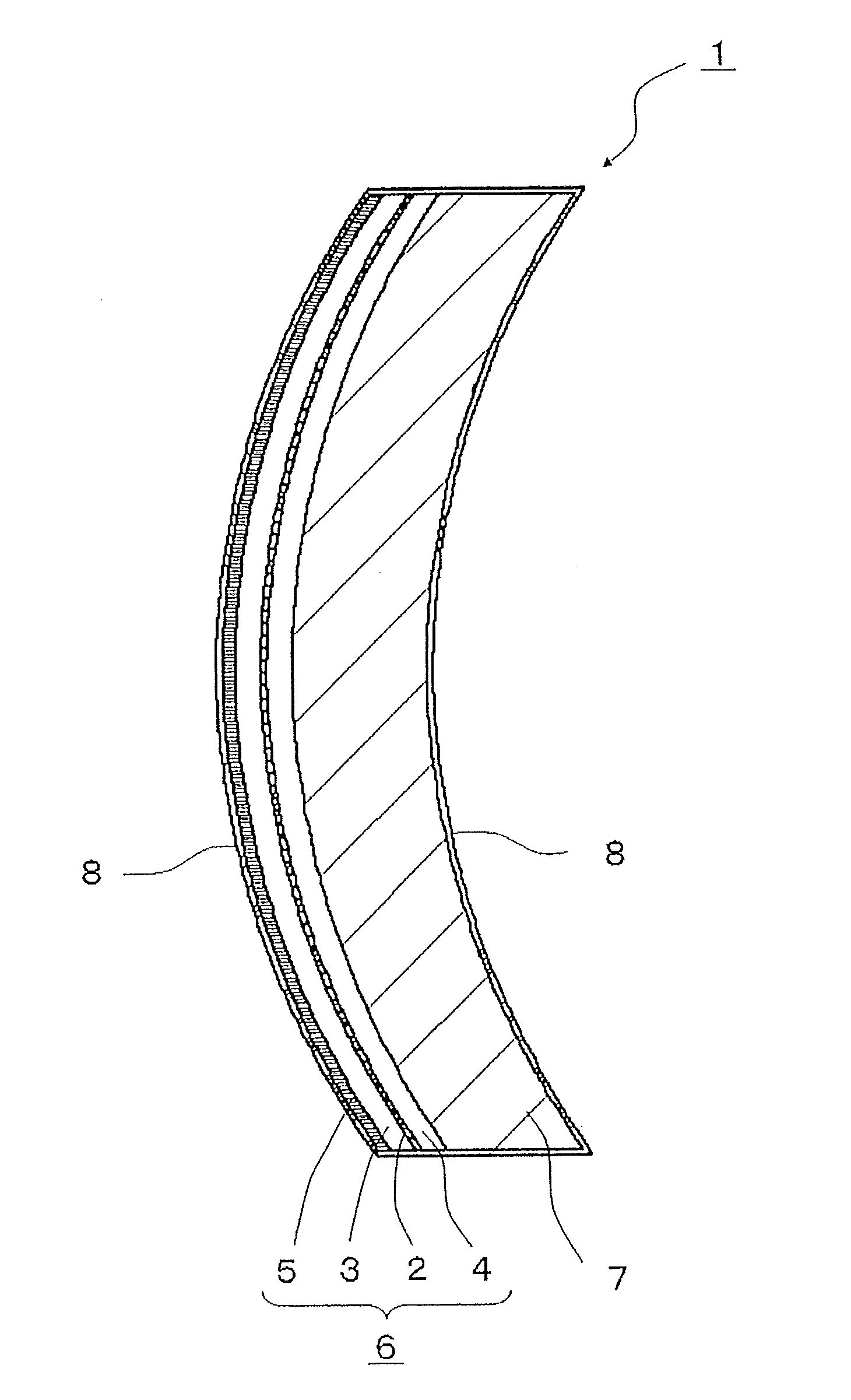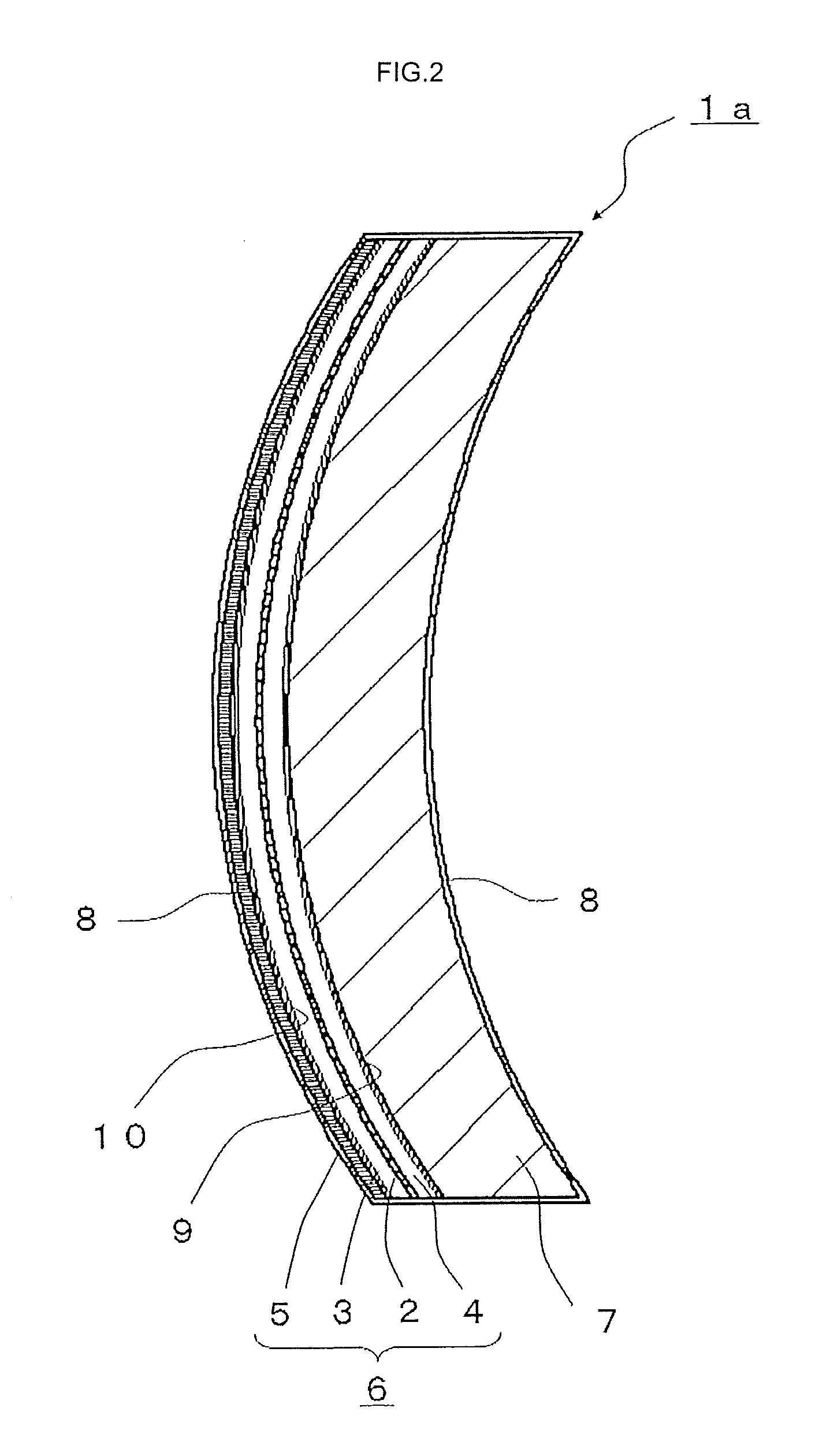Polycarbonate lens for eyewear and method for manufacturing the same
a polycarbonate lens and lens technology, applied in the field of polycarbonate lens for eyewear, can solve the problems of difficult to contain adhesive, difficult to control density, easy to strip the protective layer on the convex surface in part, etc., to reduce the interference pattern, prevent crack generation, and reduce the interference pattern of the lens
- Summary
- Abstract
- Description
- Claims
- Application Information
AI Technical Summary
Benefits of technology
Problems solved by technology
Method used
Image
Examples
first embodiment
[0026]the present invention will be described with reference to FIG. 1.
[0027]Referring to FIG. 1, the polarized polycarbonate lens for eyewear 1 configured of polarized layer 2 includes polycarbonate protective layers 3, 4 on the polarized layer 2, an acrylic coat layer 5 is formed on the convex surface of the polycarbonate protective layer 3 to form a polarized material 6 protected by the acrylic coat layer 5. Also the polarized material has lens shape with integrally bonding polycarbonate molded part 7, which has an identical chemical structure with polycarbonate protective layer 4, by injection molding on concave surface of polarizing material 6, that is to say the polycarbonate protective layer 4. Also, the polycarbonate lens is configured further to include a hard coat layer 8 over the whole surface of the lens from the convex surface of acrylic coat layer to concave surface of the polycarbonate molded part 7.
[0028]The reason why acrylic coat layer 5 is disposed only on the sur...
second embodiment
[0038]The polarized material 6 bent in the third step S3 is disposed on tinted layers 12, 13 on the convex and the concave surface of polarized material 6 tinted in dyeing liquid in the following fourth step S4. The tinted layers 12, 13 are tinted by means of immersing in dyeing liquid with up-and-down to obtain gradation pattern. Also, the tinted layer 13 on the acrylic coat layer 5, as described in aforementioned second embodiment, forms layer on convex surface of polycarbonate protective layer 3 penetrating and tinting this acrylic coat layer 5 when tinting the convex acrylic coat layer 5 consisting the polarized material 6. Additionally, tinting can be chosen by design of polycarbonate lens for eyewear without sticking gradation pattern.
[0039]The figure shows colored lens immersed with shaking up-and-down in dyeing liquid with left side of lens aimed downward, and the figure shows tinted layers 12 and 13 in coloring step of the fourth step S4, with the layers are thick in left s...
embodiment 1
[0058]According to table 1 that shows evaluation of 6 samples above, samples 4 to 6 of polycarbonate lenses for eyewear, which include an acrylic coat layer on the surface of the polycarbonate protective layer on one side surface thereof, and further include a hard coat layer on the surface of the acrylic coat layer, as described in the embodiment 1 and the following embodiments, have better “surface hardness” comparison with samples 1 to 3, which do not include. Moreover, samples 5 and 6 with a hard coat layer of two-layer including a primer layer have better “surface hardness”. In addition, as to “interference pattern”, the lens with both of an acrylic coat layer and a primer layer has better result, regardless whether the gradation dyeing is performed.
PUM
| Property | Measurement | Unit |
|---|---|---|
| thickness | aaaaa | aaaaa |
| refractive index | aaaaa | aaaaa |
| thickness | aaaaa | aaaaa |
Abstract
Description
Claims
Application Information
 Login to View More
Login to View More - R&D
- Intellectual Property
- Life Sciences
- Materials
- Tech Scout
- Unparalleled Data Quality
- Higher Quality Content
- 60% Fewer Hallucinations
Browse by: Latest US Patents, China's latest patents, Technical Efficacy Thesaurus, Application Domain, Technology Topic, Popular Technical Reports.
© 2025 PatSnap. All rights reserved.Legal|Privacy policy|Modern Slavery Act Transparency Statement|Sitemap|About US| Contact US: help@patsnap.com



